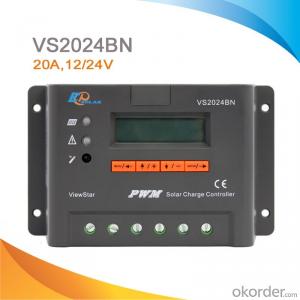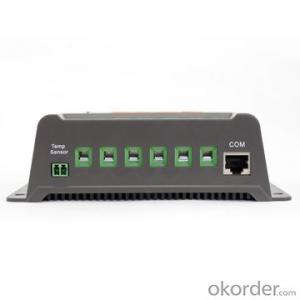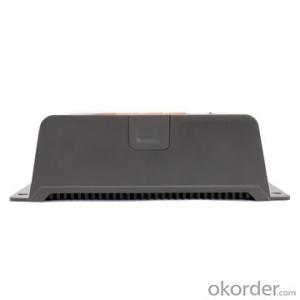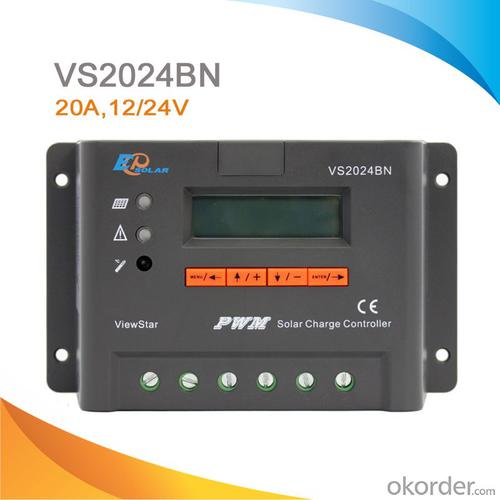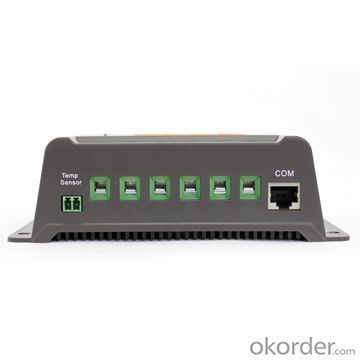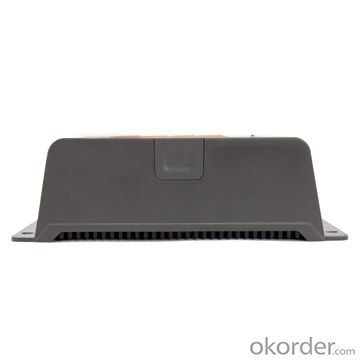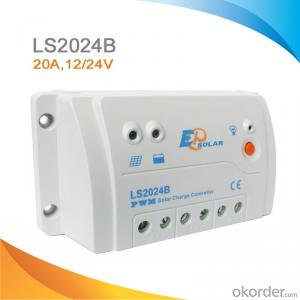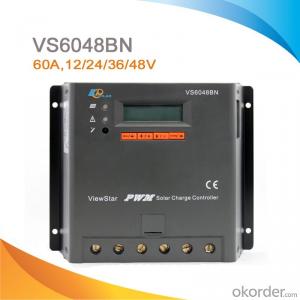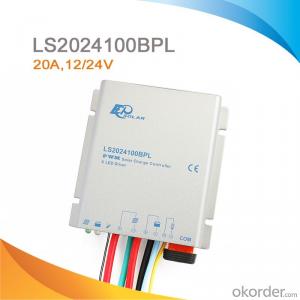LCD/LED High Quality PWM Solar anel charge controller/regulator 10a 12/24v with CE ROHS 20A ,12V/24V,VS2024BN
- Loading Port:
- Tianjin
- Payment Terms:
- TT or LC
- Min Order Qty:
- -
- Supply Capability:
- 10000 pc/month
OKorder Service Pledge
OKorder Financial Service
You Might Also Like
Features:
·Excellent EMC design
·32 bit MCU with high speed
·High efficient Series PWM charging
·Four battery type options: Sealed, Gel, Flooded, and USER
·Intelligent lighting and timer control for solar lighting system
·12 bit A/D high-precision sampling to ensure accuracy
·Use MOSFET as electronic switch
·Full control parameters setting and modification, diversified load control mode
·Humanized design of browser interface, undertake every operating conveniently
·Temperature compensation
·Adopt graphics dot-matrix LCD screen and HMI (human-machine interface) with 4 buttons,integrated menu displaying and operation
·Energy statistics function
·RS485 ports with MODBUS communication protocol
·Optional PC monitoring software and remote meter for real-time monitoring and battery management parameter setting
·Field upgradable firmware
Electronic Protections:
·PV short circuit protection
·PV reverse polarity protection
·Battery overcharge protection
·Battery over discharge protection
·Battery reverse polarity protection
·Load overload protection
·Load short circuit protection
·Overheating protection
Specification:
Model | cn1 | cn2 | cn3 | cn4 | cn5 |
Nominal system voltage | 12V/24V auto work | ||||
Rated battery current | 10A | 20A | 30A | 45A | 60A |
Rated load current | 10A | 20A | 30A | 45A | 60A |
Max. battery voltage | 32V | ||||
Equalize charging voltage | Sealed: 14.6V, Flooded: 14.8V, User-defined: 9~17V | ||||
Boost charging voltage | Gel: 14.2V, Sealed: 14.6V, Flooded: 14.8V, User-defined: 9~17V | ||||
Float charging voltage | Gel /Sealed /Flooded: 13.8V, User-defined: 9~17V | ||||
Low voltage reconnect voltage | Gel /Sealed /Flooded: 12.6V, User-defined: 9~17V | ||||
Low voltage disconnect voltage | Gel /Sealed /Flooded: 11.1V, User-defined: 9~17V | ||||
Self-consumption | ≤15mA(12V); ≤10mA(24V); ≤9mA(36V); ≤8mA(48V) | ||||
Grounding | Common negative | ||||
Temp. compensation | -3mV/°C/2V | ||||
Relative humidity | 10%~90% Non-condensation | ||||
Communication | RS485 / RJ45 interface | ||||
LCD temperature | -20°C ~ +70°C | ||||
Working temperature | -25°C ~ +55°C | ||||
Humidity | ≤95% N.C. | ||||
Enclosure | IP30 | ||||
Overall dimension | 162x85x40mm | 162x100x50mm | 200x103x58mm | 201x109x59mm | 205x129x67mm |
Terminals | 4mm2 | 10mm2 | 16mm2 | 35mm2 | 35mm2 |
Net weight | 0.2kg | 0.4kg | 0.7kg | 0.9kg | 1.3kg |
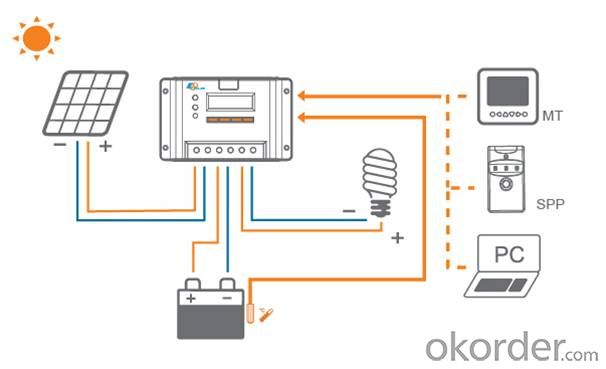

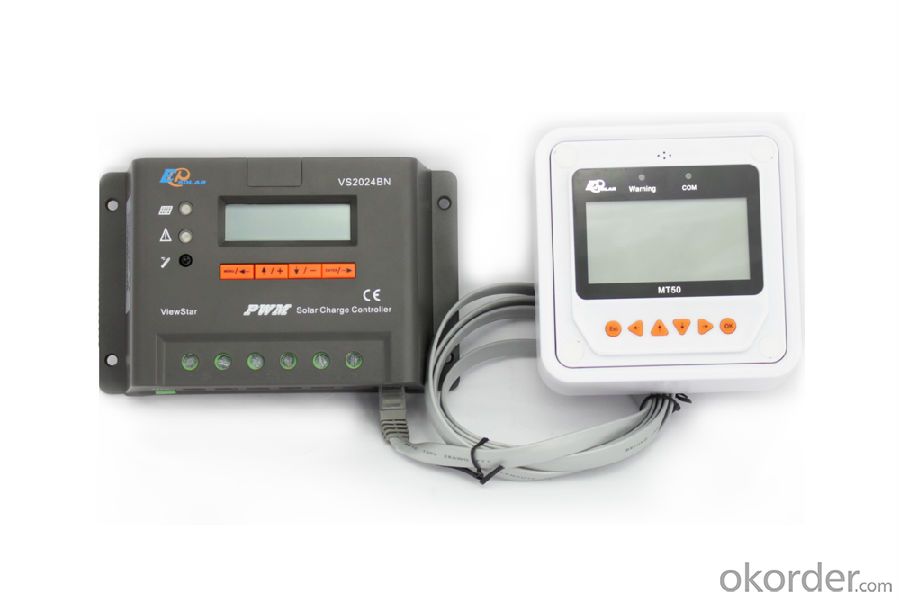
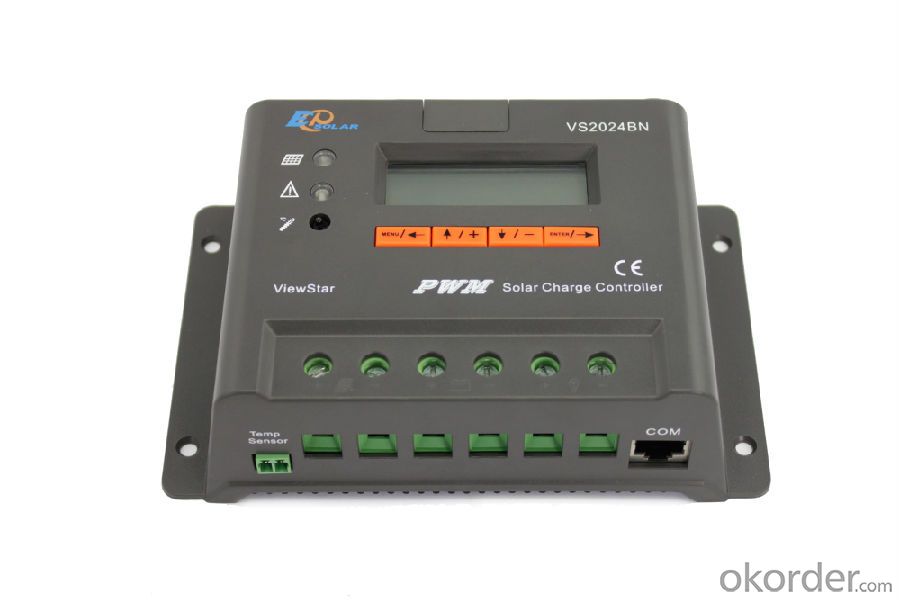
FAQ:
Q1. What is the voltage?
A1. Our 45/60A solar charge controller is 12/24/36/48V auto work.
Q2. What is the difference between MPPT&PWM?
A2. MPPT has higher efficiency, it can track the max power point and won't waste energy.
Q3. What is the efficiency of the MPPT controller?
A3. MPPT>99%, peak conversion efficiency>98%.
Q4. What is the waranty of product?
A4. 12 months.
Q5. What protection does your MPPT controller have?
A5. PV array short circuit, PV reverse polarity, Battery reverse polarity, Over charging, Output short circuit.
- Q: How do I monitor the performance of a solar controller?
- To monitor the performance of a solar controller, you can follow these steps: 1. Check the controller's display: Most modern solar controllers come with an LCD display that provides real-time information about the system's performance. This display typically shows important details such as battery voltage, charging current, load status, and solar panel output. 2. Use a monitoring app or software: Some solar controllers have Bluetooth or Wi-Fi connectivity options, allowing you to connect them to a mobile app or software on your computer. These monitoring tools provide detailed data, historical performance, and even send alerts for any potential issues. 3. Verify battery charging: A key aspect of a solar controller's performance is its ability to charge the batteries effectively. Monitor the battery voltage regularly to ensure that it is being maintained at the desired level, and check if the controller is providing the right charging current. 4. Observe load management: If your solar controller includes load management functionality, keep an eye on how it controls the power usage in your system. Make sure it operates as intended, prioritizing essential loads and preventing battery over-discharge. 5. Periodic inspections: Physically inspect the solar controller and its connections to ensure there are no loose wires, signs of damage, or corrosion. Regular inspections help identify any potential issues that may affect its performance. 6. Compare with expected values: Familiarize yourself with the specifications and expected performance of your solar controller. This will enable you to compare its actual measurements with the anticipated values and promptly identify any deviations. By regularly monitoring the performance of your solar controller, you can ensure efficient operation, detect issues early on, and take appropriate actions to maximize the benefits of your solar power system.
- Q: How does a solar controller handle temperature compensation for the battery?
- A solar controller handles temperature compensation for the battery by adjusting the charging voltage based on the battery's temperature. The controller monitors the battery's temperature and compares it to a predetermined temperature compensation curve. This curve determines the appropriate charging voltage for the battery at different temperature levels. When the battery is cold, the controller increases the charging voltage to ensure efficient charging and prevent undercharging. In cold temperatures, the battery's internal resistance increases, which can lead to a drop in charging efficiency. By increasing the charging voltage, the controller compensates for this increase in resistance and provides the necessary energy to fully charge the battery. On the other hand, when the battery is hot, the controller reduces the charging voltage to prevent overcharging. High temperatures can accelerate the battery's chemical reactions, leading to increased gassing and loss of electrolyte. By lowering the charging voltage, the controller prevents overcharging, which not only prolongs the battery's lifespan but also ensures its safety. Overall, the temperature compensation feature of a solar controller optimizes the charging process by adjusting the charging voltage to match the battery's temperature. This helps maintain the battery's performance, prolong its lifespan, and ensure efficient and safe charging.
- Q: What is the maximum load voltage of a solar controller?
- The maximum load voltage of a solar controller refers to the highest voltage that can be handled and regulated by the controller when supplying power to a load.
- Q: How does a solar controller prevent overloading of the system?
- A solar controller prevents overloading of the system by regulating the flow of electricity from the solar panels to the battery and load. It constantly monitors the voltage and current levels and adjusts the charging or discharging rate accordingly. When the battery reaches its maximum capacity, the solar controller cuts off the charging to prevent overcharging. Similarly, if the load draws more power than the system can handle, the solar controller limits the amount of energy supplied. This ensures the system operates within its safe limits and prevents damage or malfunction due to overloading.
- Q: Can a solar controller be used with a solar-powered drone?
- Yes, a solar controller can be used with a solar-powered drone. A solar controller is responsible for regulating the power flow between the solar panels and the drone's battery, ensuring efficient charging and preventing overcharging. It helps optimize the use of solar energy and ensures the drone operates smoothly and reliably.
- Q: How do I determine the maximum load output power for a solar controller?
- To determine the maximum load output power for a solar controller, you need to refer to the specifications provided by the manufacturer. The maximum load output power is typically stated in the product manual or datasheet. It is important to check for the maximum load output power rating to ensure that it can handle the power requirements of your specific load or device.
- Q: Can a solar controller be used with solar-powered indoor healthcare institutions?
- Yes, a solar controller can be used with solar-powered indoor healthcare institutions. A solar controller is essential for managing and regulating the power generated by solar panels, ensuring optimal charging and protection of batteries. In healthcare institutions, solar power can be used to provide electricity for lighting, medical equipment, and other essential functions, reducing reliance on the grid and ensuring uninterrupted power supply.
- Q: What is the maximum load current for a solar controller?
- The maximum load current for a solar controller depends on the specific model and its specifications. It can range from a few amps to several hundred amps, depending on the capacity and design of the controller.
- Q: How do I clean and maintain a solar controller?
- To clean and maintain a solar controller, follow these simple steps: 1. Switch off the solar controller and disconnect it from the power source. 2. Use a clean, dry cloth or a soft brush to gently remove any dust or debris from the surface of the controller. 3. If there are stubborn stains or dirt, dampen the cloth with a mild soapy water solution and carefully wipe the controller. Avoid using harsh chemicals or abrasive materials that may damage the surface. 4. Pay attention to the vents or cooling fans, and use a can of compressed air or a soft brush to remove any dust or dirt that may have accumulated there. 5. Inspect the wiring connections to ensure they are secure and free from any corrosion. If you notice any loose or damaged wires, consult a professional for repairs. 6. Finally, re-connect the solar controller to the power source and switch it on. Monitor its performance regularly to identify any issues that may require further maintenance or professional assistance.
- Q: Can a solar controller be used in a residential solar system?
- Yes, a solar controller can be used in a residential solar system. A solar controller is an essential component that regulates the flow of electricity from the solar panels to the battery bank. It helps protect the batteries from overcharging or undercharging, thus optimizing their lifespan and performance. In a residential solar system, a solar controller ensures efficient energy management and helps maintain a stable and reliable power supply.
Send your message to us
LCD/LED High Quality PWM Solar anel charge controller/regulator 10a 12/24v with CE ROHS 20A ,12V/24V,VS2024BN
- Loading Port:
- Tianjin
- Payment Terms:
- TT or LC
- Min Order Qty:
- -
- Supply Capability:
- 10000 pc/month
OKorder Service Pledge
OKorder Financial Service
Similar products
Hot products
Hot Searches
Related keywords
